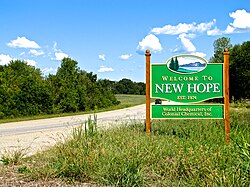New Hope, Tennessee
New Hope, Tennessee | |
|---|---|
 | |
 Location of New Hope, Tennessee | |
| Country | United States |
| State | Tennessee |
| County | Marion |
| Area | |
| • Total | 10.4 sq mi (26.9 km2) |
| • Land | 10.3 sq mi (26.7 km2) |
| • Water | 0.1 sq mi (0.1 km2) |
| Elevation | 715 ft (218 m) |
| Population (2012) | |
| • Total | 1,077 |
| • Density | 101.1/sq mi (39.0/km2) |
| Time zone | UTC-6 (Central (CST)) |
| • Summer (DST) | UTC-5 (CDT) |
| FIPS code | 47-52780[1] |
| GNIS feature ID | 1310070[2] |
New Hope is a city in Marion County, Tennessee, United States. The population was 1,082 at the 2010 census, up from 1,043 in 2000. It is part of the Chattanooga, TN–GA Metropolitan Statistical Area.
History
Originally known as Antioch, New Hope incorporated in 1974 to avoid an annexation attempt by South Pittsburg, which most of the new city's residents opposed. The name "New Hope" was taken from a local church and cemetery.[3]
Geography
New Hope is located at 35°0′0″N 85°39′12″W / 35.00000°N 85.65333°W (35.000112, -85.653332).[4] The city occupies the south side of a U-shaped bend of the Tennessee River, mostly downstream from Nickajack Dam. The city's municipal boundary stretches southward to the Tennessee-Alabama state line. South Pittsburg lies across the river to the west, Kimball and Jasper lie across the river to the north, and Nickajack Lake lies to the east. State Route 156 spans New Hope from east-to-west, connecting the city with U.S. Route 72 in South Pittsburg and Interstate 24 near Haletown.
According to the United States Census Bureau, the city has a total area of 10.4 square miles (27 km2), of which 10.3 square miles (27 km2) is land and 0.1 square miles (0.26 km2) (0.58%) is water.
Demographics
| Census | Pop. | Note | %± |
|---|---|---|---|
| 1980 | 681 | — | |
| 1990 | 854 | 25.4% | |
| 2000 | 1,043 | 22.1% | |
| 2010 | 1,082 | 3.7% | |
| 2015 (est.) | 1,067 | [5] | −1.4% |
| Sources:[6][7] | |||
As of the census[1] of 2000, there were 1,043 people, 400 households, and 303 families residing in the city. The population density was 101.1 people per square mile (39.0/km²). There were 433 housing units at an average density of 42.0 per square mile (16.2/km²). The racial makeup of the city was 98.75% White, 0.58% African American, 0.10% Native American, 0.10% Asian, 0.10% from other races, and 0.38% from two or more races.
There were 400 households out of which 36.3% had children under the age of 18 living with them, 63.8% were married couples living together, 8.8% had a female householder with no husband present, and 24.3% were non-families. 21.8% of all households were made up of individuals and 8.3% had someone living alone who was 65 years of age or older. The average household size was 2.61 and the average family size was 3.02.
In the city the population was spread out with 26.7% under the age of 18, 6.4% from 18 to 24, 31.4% from 25 to 44, 26.6% from 45 to 64, and 8.9% who were 65 years of age or older. The median age was 36 years. For every 100 females there were 95.0 males. For every 100 females age 18 and over, there were 88.9 males.
The median income for a household in the city was $35,179, and the median income for a family was $38,500. Males had a median income of $31,771 versus $23,438 for females. The per capita income for the city was $15,424. About 13.0% of families and 14.8% of the population were below the poverty line, including 15.9% of those under age 18 and 8.5% of those age 65 or over.
References
- ^ a b "American FactFinder". United States Census Bureau. Retrieved 2008-01-31.
- ^ "US Board on Geographic Names". United States Geological Survey. 2007-10-25. Retrieved 2008-01-31.
- ^ Larry Miller, Tennessee Place Names (Indiana University Press, 2001), p. 149.
- ^ "US Gazetteer files: 2010, 2000, and 1990". United States Census Bureau. 2011-02-12. Retrieved 2011-04-23.
- ^ "Annual Estimates of the Resident Population for Incorporated Places: April 1, 2010 to July 1, 2015". Retrieved July 2, 2016.
- ^ "Census of Population and Housing: Decennial Censuses". United States Census Bureau. Retrieved 2012-03-04.
- ^ "Incorporated Places and Minor Civil Divisions Datasets: Subcounty Resident Population Estimates: April 1, 2010 to July 1, 2012". Population Estimates. U.S. Census Bureau. Retrieved 11 December 2013.
External links
 Media related to New Hope, Tennessee at Wikimedia Commons
Media related to New Hope, Tennessee at Wikimedia Commons- Municipal Technical Advisory Service entry for New Hope — information on local government, elections, and link to charter

